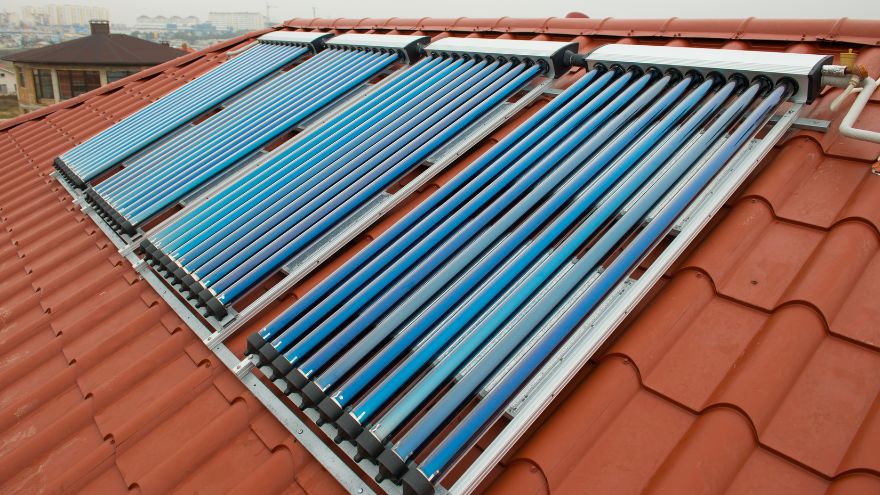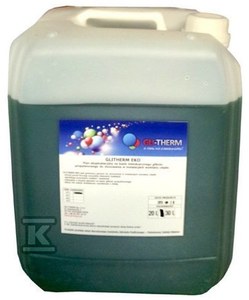Solar fluid, i.e. a special liquid that allows heat to be transported from the solar collectors installed in the installation to the tank in the house. This liquid has specific properties that help in effective and efficient heating. What properties does propylene glycol have, how often should it be replaced in the collectors and what volume of fluid enters the installation? We answer!

Check out solar fluids at the Onninen wholesaler
Properties of propylene glycol
Correct transport of thermal energy is only possible when the system is operational. To reduce the risk of failure, it must be filled with an appropriate fluid with special properties. One of the most important features is frost resistance, which prevents the fluid in the system from freezing in winter. Not only protection against cold is important, but high temperatures can also lead to failure. Propylene glycol must be corrosive and the pH of the fluid must not negatively affect the system components. The solar fluid must not foam under the influence of installation pressure and temperature .
Therefore, for the installation you need to buy an appropriate fluid, prepared on the basis of glycol , with special additives, such as: anti-foaming agents, corrosion inhibitors, dyes and oxidants. Thanks to them, it is possible to secure the system. If it were not for the anti-foaming agents, the solar fluid could turn into a gas, which would lead to ineffective heat exchange and cavitation. In turn, oxidants and dyes help assess the condition of the solar fluid . If the fluid in the system changes color, it may indicate that it is aging and needs to be replaced .
How often should the solar fluid in collectors be replaced?
In the case of solar collectors , a very important issue is that the liquid in the system must be replaced regularly. Fluid aging is a natural process, but failure to replace it could lead to serious failures. The fluid in the system changes its properties under the influence of temperature.
 Especially in summer, high temperatures could lead to significant water heating, exceeding the boiling point . Overheating may occur when the fluid does not circulate in the system, so it is not possible to release the generated heat, which may happen, for example, in the event of a power outage or failure of an overheated tank. These situations negatively affect the properties of propylene glycol , which is why it is so important to check it regularly.
Especially in summer, high temperatures could lead to significant water heating, exceeding the boiling point . Overheating may occur when the fluid does not circulate in the system, so it is not possible to release the generated heat, which may happen, for example, in the event of a power outage or failure of an overheated tank. These situations negatively affect the properties of propylene glycol , which is why it is so important to check it regularly.
Theoretically, it is assumed that if the solar installation works properly, the liquid in the system should be replaced on average once every five years. In practice, many manufacturers emphasize that the main determinant of replacement time should not be time, but the quality of the fluid. It is best to decide on the need to replace it individually, checking the properties of the fluid regularly, because only this will protect the solar collectors and the entire system from damage. Lack of proper monitoring may lead, for example, to water freezing during severe frosts and costly repairs.
How much propylene glycol goes into a solar installation?
Please remember that the entire fluid must be replaced for the system to function properly . How much liquid will enter the solar installation depends on its size. It is best to leave the replacement to professionals, because any errors may negatively affect the efficiency of the entire system. An additional advantage is that specialists will check the entire installation , including pressure , tightness, and whether the circulation pump is working properly.
When purchasing solar fluid, remember that an adequate supply is always necessary. After filling the system with solar fluid, it is necessary to vent the entire installation in the solar collectors .
Onnline GliTherm solar fluid in the Onninen wholesaler
The Onninen installation wholesaler 's offer includes GliTherm EKO-35 solar fluid . The 20-liter package contains non-toxic propylene glycol. This is sufficient protection against frost and corrosion, which additionally protects the installation against the formation of possible deposits inside, including the development of microbiological life. The solar fluid is easily degradable, so it is not harmful to the natural environment, people or animals.
Good quality propylene glycol works at temperatures down to -35 degrees, which ensures adequate protection in typical Polish climatic conditions. The solar fluid available in the Onninen offer is a product with all the necessary certificates, which guarantees safety and proper operation at a specific temperature . The product effectively transports heat , ensuring optimal functioning of the entire installation.